| |
Friday, July 25, 2008, 1:19 AM GeneralPosted by stefanie Until last night, things had settled down for us, geologically speaking. The aftershocks from the Iwate-Miyagi earthquake had pretty much stopped. Small tremors occurred occasionally, but nothing really out of the ordinary ― a shindo 3 here, a shindo 2 there. Until last night, when the glasses started rattling and the ceiling lights started bouncing, the prelude to a whooshing roar as our second big earthquake intensified. The quake registered as a 6.8 on the Richter scale, with its epicenter about 65 km from here, east of Morioka. Areas close to the epicenter had landslides and some fires; Kitakami escaped relatively unscathed once again. JR East didn't resume train service until about 1:45 pm, but people who needed to travel simply found other ways, and we went on with our lives. There are two attitudes frequently associated with the Japanese people. One is ganbaru ― perseverance, or striving to do one's best. It is expressed in many ways: as a spirited cry during a sporting event, as an exhortation from one classmate to another struggling with an answer, as a soft bit of encouragement from a mother to an injured child. The other is shou ga nai ― there is nothing to be done, or there is no help for it. It is an attitude of acceptance that there are things over which we have no control, and all we can do is let the chips fall where they may. Over the millennia during which the Japanese formed these attitudes, the earthquakes must have played a role. What, after all, can you do about the earth moving, splitting and collapsing as it does? You can give up, which at best makes you a quivering mound of fear every time the house creaks and at worst leaves you with a life and community possibly in ruins. It doesn't prevent the quakes from happening. You must persevere. You must go on. And you must do so with every expectation that the earth will awaken again. When Mother Earth needs to let off some stress by shifting plates around ― there is nothing to be done. You can only accept that it will happen, and persevere when it does.
After a little over a year on the Japanese cooking scene, I've gotten quite an education. I'm a bit of a purist, so I've been focusing on using seasonal ingredients and learning traditional techniques. As a general rule, I prefer to avoid processed things ― for example, I won't use okonomiyaki mix because while making it from scratch is a little more involved and itchy (stupid nagaimo juice), it's still really easy and the payoff is good. I don't mind fiddly, time-consuming, involved things if the end result is worth it. Which is why my first experience with making chirashi-zushi was such a downer. Chirashi-zushi is essentially vinegared rice with seasoned things mixed in and other things scattered on top. Making it from scratch took the better part of an evening: cooking and seasoning each of the ingredients individually, vinegaring the rice and fanning it while stirring, and finally mixing and topping it with the other ingredients. It looked pretty, but it was really underwhelming. Some of the ingredients were undercooked and strongly seasoned, while others were overcooked and strongly seasoned, almost to the point of being candied. The latter point, though, provided a valuable lesson: if you're cooking a mixture involving soy sauce and mirin and it starts to smell like battery acid, it's too far gone. I shared my sad story of battery-acid-smelling disappointment with a friend. She laughed, then shared her secret. "I'm too busy to make it from scratch," she said. "I use a mix." A mix?! Horrors! What about tradition, the need to use fresh ingredients, the attention to detail so commonly associated with Japanese cooking? Well, you can get freshness when you choose your toppings; as it turns out, a bag of vinegared vegetables and a pouch of shredded nori seaweed and sesame seeds comprise the mix. The result? 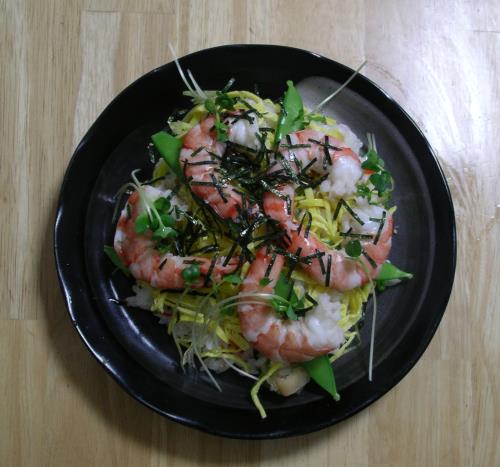 Mix chirashi was vastly superior to my scratch version. And if it's good enough for the natives, it's good enough for me.
Where the Green Fern Grows
A fern growing in the Juniko area (in Aomori Prefecture) of the Shirakami Mountains. 
[ add comment ] permalink
Somewhere across that expanse of water (seen from the Goishi Kaigan on the Iwate coast) lie the shores of California. 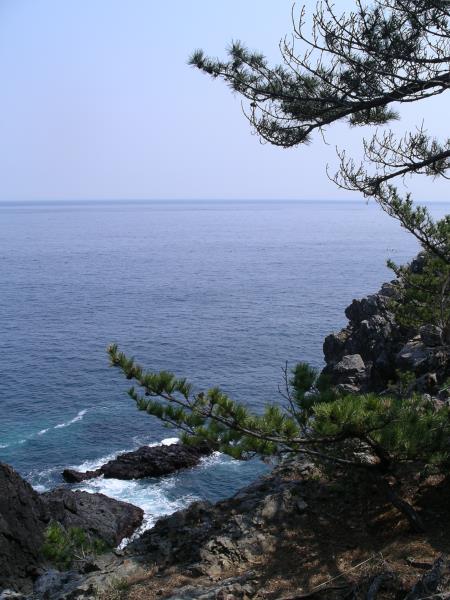
Do you remember the Pokemon craze from a few years ago? The Japanese sure do. In fact, it's still a craze here. It's even popular enough to be at the center of a joint advertising campaign between JR East and All Nippon Airways. From today until September 15, you can ride a bullet train decorated with your favorite characters. It all kicked off when one of the decorated trains (actually, a coupled set of two trains, an E3 and an E2) headed north from Tokyo, stopping at Kitakami on its way to Morioka. 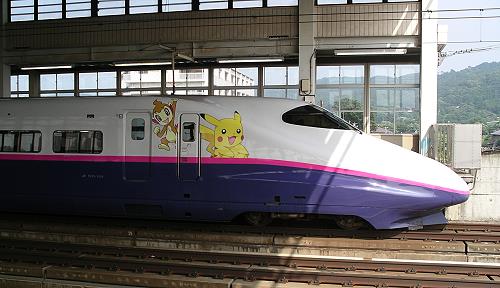 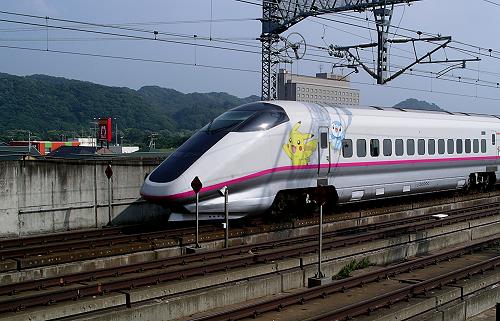
To remind motorists to watch for older people in the street, these signs appear in certain areas: 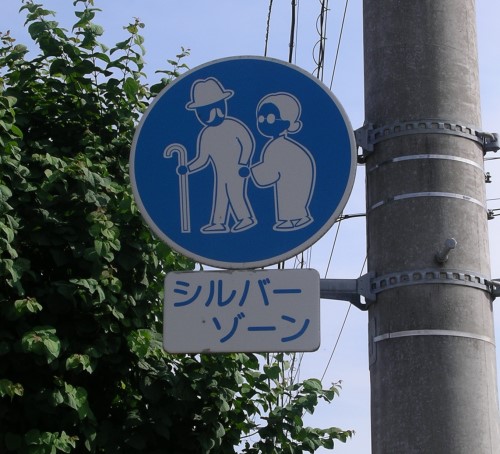 Those areas are called "Silver Zones." Aren't the signs cute?
Well, what have we here? What are you looking at? 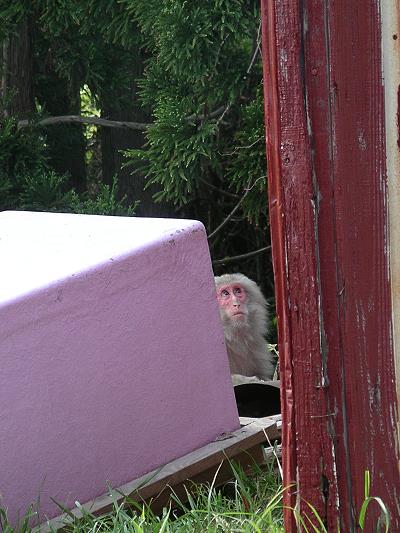 Oh, I see! You're looking at the fellow on the roof! And he's looking at us. 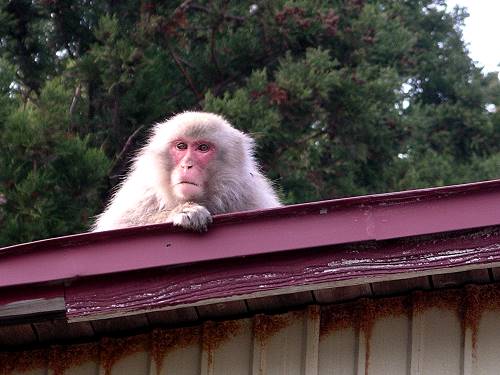 Back in May, we were driving along the Sea of Japan coast in Aomori Prefecture. We got quite a surprise when we rounded a curve and discovered a group of monkeys hanging around near the road. We stopped for some photos, and found them to be timid but curious. Eventually, they lost interest in us and returned to munching on fruit while watching the sun set over the Sea of Japan. 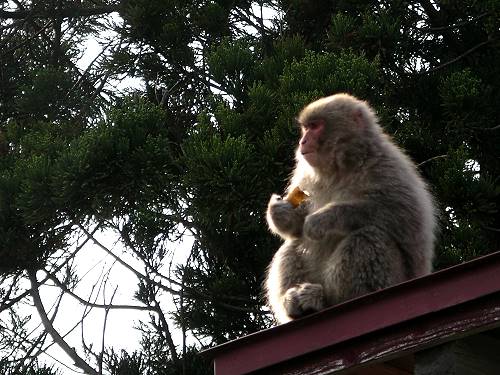
A couple of months ago, we went on a mountain vegetable-picking trip with some of our local friends. Because we had no prior experience cooking almost everything we picked, we solicited cooking tips as well. For one plant, koshiabura, a friend recommended tossing it with cooked spaghetti and pepperoncini. Japanese cooking borrows a lot from other cuisines, so I didn't think the suggestion to combine a humble mountain plant with imported Italian peppers was too offbeat. I certainly didn't think to ask whether she meant something entirely different.
Before dinner, I headed off to the store for ingredients. Regular grocery store: no pepperoncini. Booze and imported goods store: no pepperoncini. Posh department store: no pepperoncini. I was running out of time, so I made a lateral flavor jump to capers instead. The spaghetti was good, but I wondered how different it would be with the pepperoncini. It was only much later that I started wondering whether our friend had meant pickled peppers at all.
So I asked recently. "When you said 'pepperoncini,' what did you mean?" "Garlic and togarashi (Japanese red pepper). Why?" I explained the futile hunt for small yellow pickled peppers, and we both got a big laugh out of it. But next time, I'm asking what she means if she says something Western.
[ 2 comments ] permalink
During dinner at the local Okinawan joint, we ordered a new-to-us dish that came with a mystery seafood topping. We asked about it, and got an answer we didn't understand: shi-chikin. While the owner's son disappeared into the back, we consulted the electronic dictionary, but couldn't find anything under a listing for shi-chikin. It all became clear when he brought out a small can and pointed to the mermaid on the side. Sea chicken. Chicken of the Sea. Canned tuna. Canned tuna has an odd place in Japanese cooking. We find it where we'd expect to: in sandwiches and salads. We also find it where we wouldn't expect to: on pizza, in those prepackaged, unrefrigerated sandwiches with the edges pressed together and the crusts cut off, in onigiri (rice balls). It reaches the pinnacle of awesomeness in onigiri. There's no better convenience snack than a tuna-mayo onigiri ― the creamy, salty tuna, the sticky, slightly sweet rice, and the crisp, ocean-y nori are perfect together. Additionally, tuna keeps company with an unlikely sidekick: yellow corn (corn in Japanese cooking is another subject entirely). They're a surprisingly tasty duo ― corn and tuna pizza is far from the worst thing I've ever eaten. Salads now seem to lack something if they come with one or the other, but not both. Which raises a question: does the normalization of the tuna/corn partnership mean we've been here too long? It's likely that question will only linger until the next discovery of canned tuna in a completely unexpected place.
I haven't been able to determine whether it's intentional or a longstanding typo, but I love that the hospital near JR Mizusawa Station appears to have a French name:  It wouldn't be too surprising for the name to actually be French. French has a larger influence on the Japanese language than I would have expected. For example, one of the words for "clown" in Japanese is a loanword from French ― piero. Also, it seems that the more common translation of the word kuri is into French ― marron ― rather than into English ― chestnut.
[ add comment ] permalink
Back Next
|
|










 Calendar
Calendar




